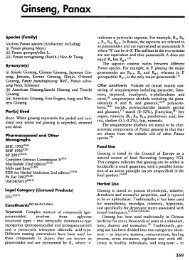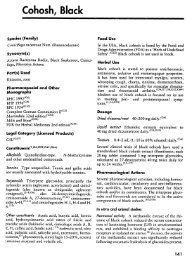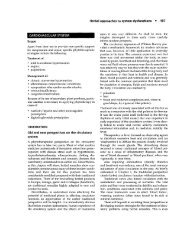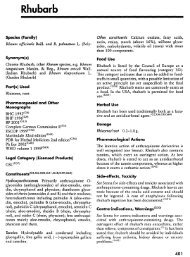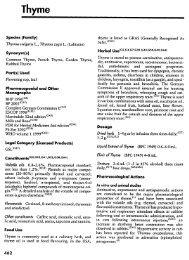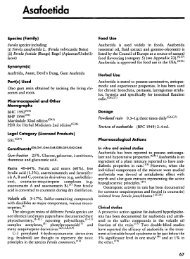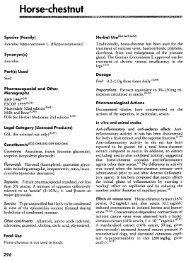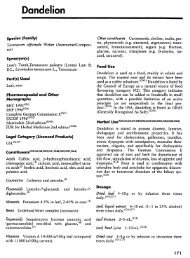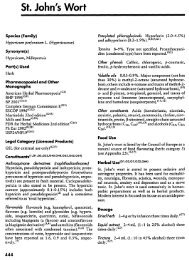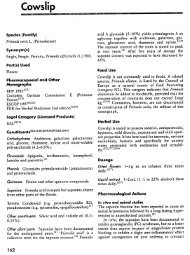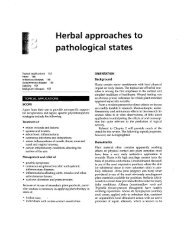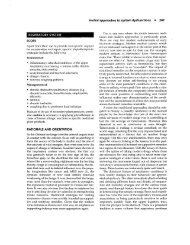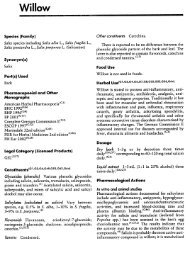Liquorice
Liquorice
Liquorice
Create successful ePaper yourself
Turn your PDF publications into a flip-book with our unique Google optimized e-Paper software.
<strong>Liquorice</strong><br />
Species (Family)<br />
Glycyrrhiza glabra L .<br />
Synonym(s)<br />
Licorice<br />
Part(s) Used<br />
Root, stolon<br />
(Leguminosae)<br />
Pharmacopoeial and Other<br />
Monographs<br />
BHC 1992 (G6)<br />
BHP 1996 (G9)<br />
BP 2001 (G15)<br />
Complete German Commission E (G3)<br />
Martindale 32nd edition (G43)<br />
Mills and Bone (G50)<br />
PDR for Herbal Medicines 2nd edition (G36)<br />
Ph Eur 2002 (G28)<br />
WHO volume 1 1999 (G63)<br />
Legal Category (Licensed Products)<br />
GSL (G37)<br />
Constituents (G2,G6,G41,G48,G64)<br />
Coumarins<br />
Glycyrin, heniarin, liqcoumarin, umbelliferone,<br />
GU-7 (3-arylcoumarin derivative) ." )<br />
Flavonoids<br />
Flavonols and isoflavones including<br />
formononetin, glabrin, glabrol, glabrone, glyzarin,<br />
glycyrol, glabridin and derivatives, kumatakenin,<br />
licoflavonol, licoisoflavones A and B, licoisoflavanone,<br />
licoricone, liquiritin and derivatives, phaseollinisoflavan<br />
;(2) chalcones including isoliquiritigenin,<br />
licuraside, echinatin, licochalcones A and B, neolicuroside<br />
.' 3)<br />
Terpenoids<br />
Glycyrrhizin glycoside (1-24%) also<br />
known as glycyrrhizic or glycyrrhizinic acid yielding<br />
glycyrrhetinic (or glycyrrhetic) acid and glucuronic<br />
acid following hydrolysis ; (4) glycyrrhetol, glabrolide,<br />
licoric acid, liquiritic acid and (3-amyrin .<br />
Volatile oils<br />
0.047% . ( S) More than 80 components<br />
identified including anethole, benzaldehyde, butyrolactone,<br />
cumic alcohol, eugenol, fenchone, furfuryl<br />
alcohol, hexanol, indole, linalool, y-nonalactone,<br />
oestragole, propionic acid, a-terpineol and thuione (S)<br />
Other constituents<br />
Amino acids, amines, gums, lignin,<br />
starch, sterols (J3-sitosterol, stigmasterol), sugars<br />
and wax .<br />
Other plant parts Components documented for the<br />
leaves ofG . glabra include flavonoids (kaempferol<br />
and derivatives, isoquercetin, quercetin and derivatives,<br />
phytoalexins), coumarins (bergapten, xanthotoxin),<br />
phytoestrogen, j3-sitosterol and<br />
saponaretin !6)<br />
Food Use<br />
<strong>Liquorice</strong> is widely used in foods as a flavouring<br />
agent . <strong>Liquorice</strong> root is listed by the Council of<br />
Europe as a natural source of food flavouring<br />
(category N2) . This category indicates that liquorice<br />
can be added to foodstuffs in small quantities, with a<br />
possible limitation of an active principle (as yet<br />
unspecified) in the final product .' 16) In the USA,<br />
liquorice is listed as GRAS (Generally Recognised As<br />
Safe ) . (G41)<br />
Herbal Use (G2,G6,G7,G8,G10,G64)<br />
<strong>Liquorice</strong> is stated to possess expectorant, demulcent,<br />
antispasmodic, anti-inflammatory and laxative properties<br />
. Traditionally, it is also reported to affect<br />
the adrenal glands . It has been used for bronchial<br />
catarrh, bronchitis, chronic gastritis, peptic ulcer,<br />
colic and primary adrenocortical insufficiency .<br />
Dosage<br />
Powdered root<br />
daily . (G6,G7)<br />
1-4g or by decoction three times<br />
<strong>Liquorice</strong> Extract (BPC 1973) 0 .6-2 .Og .<br />
Pharmacological Actions<br />
The pharmacological actions of liquorice have been<br />
reviewed ., 8) 325
326 <strong>Liquorice</strong><br />
In itro and animal studies<br />
Much has been documented regarding the steroidtype<br />
actions of liquorice (see Side-effects, Toxicity) .<br />
Both glycyrrhizin and glycyrrhetinic acid (GA) ha e<br />
been reported to bind to glucocorticoid and mineralocorticoid<br />
receptors with moderate affinity, and to<br />
oestrogen receptors, sex hormone-binding globulin<br />
and corticosteroid-binding globulin with ery weak<br />
affinity . (") It has been suggested that glycyrrhizin<br />
and glycyrrhetinic acid may influence endogenous<br />
steroid acti ity ia a receptor mechanism, with displacement<br />
of corticosteroids or other endogenous<br />
steroids . (9)<br />
The anti-oestrogenic action documented for glycyrrhizin<br />
at relati ely high concentrations has been<br />
associated with a blocking effect that would be<br />
caused by glycyrrhizin binding at oestrogen receptors<br />
. (9) Howe er, oestrogenic acti ity has also been<br />
documented for liquorice and attributed to the isofla<br />
one constituents . (8) <strong>Liquorice</strong> exhibits an alternati<br />
e action on oestrogen metabolism, causing<br />
inhibition if oestrogen concentrations are high and<br />
potentiation when concentrations are low . (8)<br />
The relati ely low affinity of glycyrrhizin and<br />
glycyrrhetinic acid for binding to mineralocorticoid<br />
receptors, together with the fact that liquorice does<br />
not exert its mineralocorticoid acti ity in adrenalectomised<br />
animals, indicates that a direct action at<br />
mineralocorticoid receptors is not the predominant<br />
mode of action . (12) It has been suggested that glycyrrhizin<br />
and glycyrrhetinic acid may exert their mineralocorticoid<br />
effect ia an inhibition of 11(3-<br />
hydroxysteroid dehydrogenase (11(3-OHSD) . (12)<br />
11(3-OHSD is a microsomal enzyme complex found<br />
predominantly in the li er and kidneys which catalyses<br />
the con ersion of cortisol (potent mineralocortoid<br />
acti ity) to the inacti e cortisone . Deficiency of<br />
11(3-OHSD results in increased concentrations of<br />
urinary free cortisol and cortisol metabolites . Glycyrrhetinic<br />
acid has been shown to inhibit renal 11(3-<br />
OHSD in rats . (12) It has also been proposed that<br />
glycyrrhizin and glycyrrhetinic acid may displace<br />
cortisol from binding to transcortin . (13)<br />
Antiplatelet acti ity in itro has been documented<br />
for a 3-a lcoumarin deri ati e, GU-7, isolated from<br />
liquorice' ) GU-7 was thought to inhibit platelet<br />
aggregation by increasing intraplatelet cyclic AMP<br />
concentration .<br />
Isoliquiritigenin has been reported to inhibit<br />
aldose reductase, the first enzyme in the polyol pathway<br />
which reduces glucose to sorbitol . (~ 4) Isoliquiritigenin<br />
was subsequently found to inhibit sorbitol<br />
accumulation in human red blood cells in itro, and<br />
in red blood cells, the sciatic ner e and the lens of<br />
diabetic rats administered isoliquirigenin intragastrically<br />
. ( 14 .15) Many diabetic complications, such as<br />
cataracts, peripheral neuropathy, retinopathy and<br />
nephropathy ha e been associated with the polyol<br />
pathway and ha e shown impro ement with inhibitors<br />
of aldose reductase . (14,15)<br />
Significant anti-inflammatory action is exhibited<br />
by glycyrrhetinic acid against UV erythema . (16) 18a-<br />
Glycyrrhetinic acid has exhibited stronger antiinflammatory<br />
action compared to its stereoisomer<br />
18(3-glycyrrhetinic acid . ( 17 Chalcones isolated from<br />
G . inflata Bat . ha e been reported to inhibit leukotriene<br />
production and increase cyclic AMP concentrations<br />
in human polymorphonuclear neutrophils<br />
in itro . ' 18) Glycyrrhetinic acid deri ati es, but not<br />
glycyrrhetinic acid, ha e exhibited inhibitory effects<br />
on writhing and ascular . permeability tests and on<br />
type IV allergy in mice P 19) The dihemiphthalate<br />
deri ati es were especially acti e with respect to the<br />
two former acti ities and ha e pre iously been found<br />
to inhibit lipoxygenase and cyclooxygenase acti ities,<br />
and to pre ent formation of gastric ulcer . (19)<br />
Glycyrrhetinic acid is known to inhibit Epstein-<br />
Barr irus acti ation by tumour promotors . (2 )<br />
Antimicrobial acti ity ersus Staphylococcus aureus,<br />
Mycobacterium smegmatis and Candida albicans<br />
has been documented for liquorice and attributed to<br />
isofla onoid constituents (glabridin, glabrol and their<br />
deri ati es) .(2) Anti iral acti ity has been described<br />
for glycyrrhetinic acid, which interacts with irus<br />
structures producing different effects according to<br />
the iral stage affected . (21) Acti ity was obser ed<br />
against accinia, herpes simplex 1, Newcastle disease<br />
and esicular stomatitis iruses, with no acti ity<br />
demonstrated towards polio irus 1 . (21)<br />
In itro hepatoprotecti e acti ity against CC14-<br />
induced toxicity has been reported to be greater for<br />
glycyrrhetinic acid compared to glycyrrhizin . (22) Glycyrrhetinic<br />
acid is thought to act by inhibition of the<br />
cytochrome P450 system required for the metabolism<br />
of CC14 to the highly reacti e radical CC1 3 . (22) Glycyrrhiza<br />
uralensis Fisch is used to treat hepatitis B in<br />
China, with a success rate reported to be greater than<br />
70% . (2' ) Other acti ities documented for G . uralensis<br />
are anti-inflammatory and anti-allergic, treatment<br />
of jaundice, inhibition of fibrosis of the li er, corticosteroid-like<br />
immunosuppressing effect and a detoxifying<br />
effect . (23)<br />
Screening of se eral plant extracts for antifertiliry<br />
acti ity reported liquorice to be ineffecti e following<br />
oral administration to rats in days 1-7 of pregnancy<br />
. (24)<br />
Clinical studies<br />
Carbenoxolone, an ester deri ati e of glycyrrhetinic<br />
acid, has been used in the treatment of gastric and
<strong>Liquorice</strong> 327<br />
oesophageal ulcers . I is hough o exhibi a mucosalpro<br />
ec ing effec by beneficially in erfering wi h<br />
gas ric pros anoid syn hesis, and increasing mucous<br />
produc ion and mucosal blood flow . (25)<br />
<strong>Liquorice</strong> is hough o exer i s mineralocor icoid<br />
effec by inhibi ion of he enzyme 11 R-OHSD, which<br />
ca alyses he conversion of cor isol o he inac ive<br />
cor isone (see In vi ro and animal s udies) . Adminisra<br />
ion of liquorice o heal hy volun eers has resul ed<br />
in a dis urbance of cor isol me abolism and a significan<br />
rise in urinary free cor isol, despi e here being<br />
no change in plasma concen ra ions . These changes<br />
are consis en wi h his hypo hesis, being indica ive<br />
of 11P-OHSD deficiency . (1) <strong>Liquorice</strong> has also been<br />
found o suppress bo h plasma renin ac ivi y and<br />
(26- 8)<br />
aldos erone secre ion .<br />
The pharmacokine ic profile of glycyrrhizin in ra s<br />
has been found o be similar o ha observed in<br />
humans . (29) Glycyrrhizin is primarily (80%) excre ed<br />
in o he bile from he liver agains a concen ra ion<br />
gradien . (29) This process is sa urable and can herefore<br />
affec he excre ion ra e of glycyrrhizin . In addiion,<br />
en erohepa ic recycling occurs wi h reabsorp ion<br />
of bile-excre ed glycyrrhizin from he in es inal<br />
rac . (29) Subjec s consuming 100-200g liquorice/<br />
day have been repor ed o achieve plasma I cyrrheinic<br />
acid concen ra ions of 80-480 ng/mL .<br />
Side-effec s, Toxici y<br />
Apar from confec ionery, liquorice can also be<br />
inges ed from infusions and by chewing obaccos .<br />
Excessive or prolonged liquorice inges ion has<br />
resul ed in symp oms ypical of primary hyperaldoseronism,<br />
namely hyper ension, sodium, chloride and<br />
wa er re en ion, hypokalaemia and weigh gain, bu<br />
also in low levels of plasma renin ac ivi y, aldos erone<br />
and an idiure ic hormone . (13,26,30)<br />
Raised concen ra ions of a rial na riure ic pepide<br />
(ANP), which is secre ed in response o a rial<br />
s re ch and has vasodila ing, na riure ic and diure ic<br />
proper ies, have also been observed in heal h<br />
subjec s following he inges ion of liquorice . ( '<br />
Individuals consuming be ween 10-45 g liquorice/<br />
day have exhibi ed raised blood pressure, oge her<br />
wi h a block of he aldos erone/renin axis and<br />
elec rocardiogram changes, which resolved one<br />
mon h af er wi hdrawal of liquorice . (31) Individuals<br />
consuming vas ly differing amoun s of liquorice<br />
have exhibi ed similar side-effec symp oms,<br />
indica ing ha he mineralocor icoid effec of<br />
liquorice is no dose dependen and is a sa urable<br />
process . (31<br />
Hypokalaemic myopa hy has also been associa ed<br />
wi h liquorice inges ion . (32-36) Severe hypokalaemia<br />
wi h rhabdomyolysis has been documen ed in a ma e<br />
pa ien following he inges ion of an alcohol-free<br />
beverage con aining only small amoun s of gl ycyrrhe<br />
inic acid (0 .35 g/day) . (32 j The pa ien had known<br />
liver cirrhosis due o alcohol consump ion and i was<br />
sugges ed ha cirrho ic pa ien s may be more suscepible<br />
o he mineralocor icoid side-effec s of liquorice<br />
.~32 ~ In one case,~ 34) he myoglobinaemia led o<br />
glomerulopa hy and ubulopa hy bu wi h no clinical<br />
evidence of acu e renal failure (ARF) . The la er was<br />
a ribu ed o he volume expansion also caused by he<br />
liquorice inges ion .<br />
Rhabdomyolysis wi hou myoglobinuria has been<br />
described . (37) In addi ion, severe conges ive hear<br />
failure and pulmonary oedema have been repor ed<br />
in a previously heal hy man who had inges ed 700g<br />
liquorice over eigh days . (30) <strong>Liquorice</strong> ex rac given<br />
orally has been repor ed o have a similar bu longer<br />
las ing ac ion o in ravenous deoxycor one and i has<br />
been no ed ha sodium, chloride and wa er re en ion<br />
do no have o be accompanied by clinical<br />
oedema .' 38 ~ Amenorrhoea has been associa ed wi h<br />
liquorice inges ion (an i-oes rogenic ac ion), wi h he<br />
mens rual cycle re-appearing following he wi hdrawal<br />
of liquorice . (31)<br />
I has been no ed ha symp oms of hyperaldoseronism<br />
of en resolve quickly, wi hin a few days o<br />
wo weeks, following he wi hdrawal of liquorice,<br />
even in individuals who have inges ed he subs ance<br />
for many years . (28)<br />
A case has been described where a pa ien presen<br />
ed wi h symp oms rela ed o hyperglycaemia and<br />
myopa hy secondary o liquorice-induced hypokalaemia<br />
. An inverse rela ionship was observed be ween<br />
he concen ra ions of fas ing serum glucose and<br />
serum po assium .<br />
(39)<br />
In eres ingly, animal s udies<br />
have indica ed ha liquorice may reduce diabe ic<br />
complica ions associa ed wi h in racellular accumula<br />
ion of sorbi ol . (19)<br />
Con ra-indica ions, Warnings<br />
Numerous ins ances have been documen ed where<br />
liquorice inges ion has resul ed in symp oms of<br />
primary hyperaldos eronism, such as wa er and<br />
sodium re en ion and hypokalaemia . <strong>Liquorice</strong><br />
should herefore be avoided comple ely by individuals<br />
wi h an exis ing cardiovascular-rela ed<br />
disorder, and inges ed in modera ion by o her individuals<br />
. Hypokalaemia is known o aggrava e glucose<br />
in olerance and liquorice inges ion may<br />
herefore in erfere wi h exis ing hypoglycaemic herapy<br />
. <strong>Liquorice</strong> may in erfere wi h exis ing hormonal<br />
herapy (oes rogens and an ioes rogenic ac ivi ies<br />
documen ed in vivo) .
328 <strong>Liquorice</strong><br />
Pregnancy and lactation in view of the oestrogenic<br />
and steroid efects associated with liquorice, which<br />
may exacerbate pregnancy-related hypertension,<br />
excessive ingestion during pregnancy and lactation<br />
should be avoided . In addition, liquorice has exhibited<br />
a uterine stimulant activity in animal studies, and<br />
is traditionally reputed to be an abortifacient and to<br />
afect the menstrual cycle (emmenagogue WG30)<br />
Pharmaceutical Comment<br />
The phytochemistry is well documented for liquorice<br />
and it is particularly characterised by triterpenoid<br />
components . Many of the traditional uses of liquorice<br />
are supported by documented pharmacological<br />
data although limited evidence of antispasmodic<br />
activity was found . Carbenoxolone, an ester derivative<br />
of a triterpenoid constituent in liquorice, is well<br />
known for its use in ulcer therapy . Much has been<br />
written concerning the steroid-type adverse efects<br />
associated with liquorice ingestion . <strong>Liquorice</strong> ingestion<br />
should therefore be avoided by individuals with<br />
an existing cardiovascular disorder and moderate<br />
consumption should be observed by other individuals<br />
.<br />
References<br />
See also General References G2, G3, G5, G6, G9,<br />
G12, G15, G16, G18, G21, G28, G30, G31, G32,<br />
G36, G37, G41, G43, G48, G50, G56, G63 and G64 .<br />
1 Tawata M et al . Anti-platelet action of GU-7, a 3-<br />
arylcoumarin derivative, purified from Glycyrrhizae<br />
radix . Planta Med 1990 ; 56 : 259-263 .<br />
2 Mitscher LA et al. Antimicrobial agents from<br />
higher plants . Antimicrobial isoflavanoids and<br />
related substances from Glycyrrhiza glabra L .<br />
var. typica . J Nat Prod 1980 ; 43 : 259-269 .<br />
3 Miething H, Speicher-Brinker A . Neolicuroside - A<br />
new chalcone glycoside from the roots of Glycyrrhiza<br />
glabra . Arch Pharm (Weinheim) 1989 ; 322 :<br />
141-143 .<br />
4 Takino Y et al . Quantitative determination of<br />
glycyrrhizic acid in liquorice roots and extracts by<br />
TLC-densitometry . Planta Med 1979 ; 36 : 74-78 .<br />
5 Kameoka H, Nakai K. Components of essential oil<br />
from the root of Glycyrrhiza glabra . Nippon<br />
Nogeikagaku Kaishi [J Ag Chem Soc Japan]<br />
1987 ; 61 : 1119-1121 .<br />
6 Jimenez j et al . Flavonoids of Helianthemum<br />
cinereum . Fitoterapia 1989; 60: 189.<br />
7 Chandler RF. Licorice, more than just a flavour .<br />
Can Pharin j 1985 ; 118 : 421-424 .<br />
8 Pizzorno JE, Murray AT . Glycyrrhiza glabra. A<br />
Textbook of Natural Medicine . Seattle, WA : John<br />
Bastyr College Publications, 1985 (looseleaf) .<br />
9 Tamaya MD et al. Possible meclianism of steroid<br />
action of the plant herb extracts glycyrrhizin,<br />
glycyrrhetinic acid, and paeoniflorin : Inhibition<br />
by plant herb extracts of steroid protein binding in<br />
the rabbit . Am J Obstet Gynecol 1986 ; 155 : 1134-<br />
1139 .<br />
10 Armanini D et al . Binding of agonists and<br />
antagonists to mineralocorticoid receptors in<br />
human peripheral mononuclear leucocytes . J<br />
Hypertens 1985 ; 3(Suppl .3) : S157-1S9 .<br />
11 Armanini D et al. Afinity of liquorice derivatives<br />
for mineralocorticoid and glucocorticoid receptors .<br />
Clin Endocrinol 1983 ; 19 : 609-612 .<br />
12 Stewart PM et al. Mineralocorticoid activity of<br />
liquorice : 11-beta-hydroxysteroid dehydrogenase<br />
deficiency comes of age . Lancet 1987 ; ii : 821-824 .<br />
13 Forslund T et al . Efects of licorice on plasma atrial<br />
natriuretic peptide in healthy volunteers . J Intern<br />
Med 1989 ; 225 : 95-99 .<br />
14 Aida K et al. Isoliquiritigenin: A new aldose<br />
reductase inhibitor from Glycyrrhizae radix .<br />
Planta Med 1990 ; 56 : 254-258 .<br />
15 Yun-ping Z, Jia-ging Z . Oral baicalin and liquid<br />
extract of licorice reduce sorbitol levels in red<br />
blood cell of diabetic rats . Chin Med j 1989; 102 :<br />
203-206 .<br />
16 Fujita H et al . Antiinflammatory efect of glycyrrhizinic<br />
acid . Efects of glycyrrhizinic acid against<br />
carrageenin-induced edema, UV-erythema and skin<br />
reaction sensitised with DCNB. Pharmacometrics<br />
1980; 19 : 481-484 .<br />
17 Amagaya S et al. Separation and quantitative<br />
analysis of 18a-glycyrrhetinic acid and 18(3-glycyrrhetinic<br />
acid in Glycyrrhizae radix by gas-liquid<br />
chromatography . J Chroanatogr 1985 ; 320 : 430-<br />
434 .<br />
18 Kimura Y et al. Efects of chalcones isolated from<br />
licorice roots on leukotriene biosynthesis in human<br />
polymorphonuclear neutrophils . Phytother Res<br />
1988 ; 2 : 140-145 .<br />
19 Inque H et al . Pharmacological activities of<br />
glycerrhetinic acid derivatives : Analgesic and<br />
anti-rype IV allergic efects . Chem Pharm Bull<br />
1987; 35 : 3888-3893 .<br />
20 Tokuda H et al. Inhibitory efects of ursolic and<br />
oleandolic acid on skin tumor promotion by 12-0-<br />
tetra decanoylphorbol-13-acetate . Cancer Lett<br />
1986 ; 33 : 279-285.<br />
21 Pompei R et al. Antiviral activity of glycyrrhizic<br />
acid . Experientia 1980 ; 36 : 304 .<br />
22 Kiso Y et al. Mechanism of antihepatotoxic<br />
activiry of glycyrrhizin, I : Efect on free radical<br />
generation and lipid peroxidation . Planta Med<br />
1984; 50 : 298-302 .<br />
23 Chang HM et al. Advances in Chinese Medicinal<br />
Materials Research . Singapore : World Scientific .<br />
1985 .
<strong>Liquorice</strong> 329<br />
24 Sharma BB et al. Antifertility screening of plants .<br />
Part I . Effect of ten indigenous plants on early<br />
pregnancy in albino rats. Int J Crude Drug Res<br />
1983 ; 21 : 183-187 .<br />
25 Guslandi M . Ulcer-healing drugs and endogenous<br />
prostaglandins . Int J Clin Pharmacol Ther Toxicol<br />
1985 ; 23 : 398-402 .<br />
26 Conn j et al. Licorice-induced pseudoaldosteronism.<br />
Hypertension, hypokalaemia, aldosteronopenia<br />
and suppressed plasma renin activity .<br />
JAMA 1968 ; 205 : 492-496 .<br />
27 Epstein MT et al. Effect of eating liquorice on the<br />
renin-angiotensin aldosterone axis in normal subjects<br />
. BMJ 1977; 1 : 488-490 .<br />
28 Mantero F . Exogenous mineralocorticoid-like disorders.<br />
Clin Endocrinol Metab 1981 ; 10 : 465-478 .<br />
29 Ichikawa T et a!. Biliary excretion and enterohepatic<br />
cycling of glycyrrhizin in rats . J Pharm Sci<br />
1986; 75 : 672-675 .<br />
30 Chamberlain TJ . Licorice poisoning, pseudoaldosteronism,<br />
heart failure . JAMA 1970 ; 213 : 1343 .<br />
31 Corrocher R et al . Pseudoprimary hyperaldosteronism<br />
due to liquorice intoxication . Eur Rev Med<br />
Pharmacol Sci 1983 ; 5 : 467-470 .<br />
32 Piette AM et al. Hypokali6mie majeure avec<br />
rhabdomvolase secondaire a l'ingestion de pastis<br />
non alcoolise . Ann Med Interne (Paris) 1984; 135 :<br />
296-298 .<br />
33 Cibelli G et al. Hypokalemic myopathy associated<br />
with liquorice ingestion . Ital J Neurol Sci 1984 ; 5 :<br />
463-466 .<br />
34 Heidermann HT, Kreuzfelder E . Hypokalemic<br />
rhabdomyolysis with myoglobinuria due to<br />
licorice ingestion and diuretic treatment . Klin<br />
Wochenschr 1983 ; 61 : 303-305 .<br />
35 Ruggeri CS et al . L . Carnetina cloruro e KCI nel<br />
trattamento di un caso di rabdomiolisi atraumatica<br />
senza mioglobinuria da ingestion di liquerizia .<br />
Minn Med 1985 ; 76 : 725-728 .<br />
36 Bannister B et a!. Cardiac arrest due to liquorice<br />
induced hypokalaemia . BMJ 1977; 2 : 738-739 .<br />
37 Maresca MC et a! . Low blood potassium and<br />
rhabdomyolosis . Description of three cases with<br />
different aetiologies . Minerva Med 1988; 79 : 79-<br />
81 .<br />
38 Molhuysen JA . A liquorice extract with deoxycortone-like<br />
action . Lancet 1950; ii: 381-386 .<br />
39 Jamil A et al. Hyperglycaemia related to licoriceinduced<br />
hypokalaemia . J Kwt Med Assoc 1986; 20 :<br />
69-71 .



